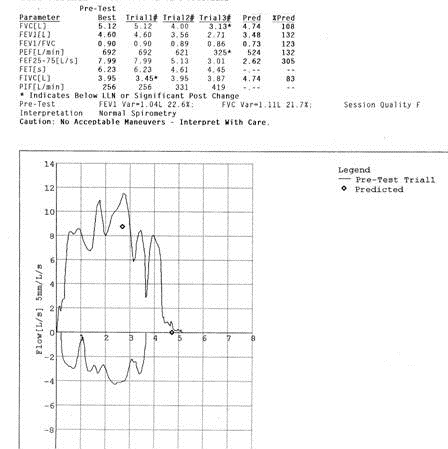The August Arizona Thoracic Society was held on 8/16/2011 at Scottsdale Shea beginning at 6:55 PM. There were 25 in attendance representing the pulmonary, radiology, and surgery communities.
Nine cases were presented:
1. Spontaneous Pneumothorax Secondary to Aspergilloma
Jud Tillinghast and Michael Caskey presented a case of a 65-year-old man with right upper lobe pneumonia on chest x-ray who was asymptomatic. Repeat chest x-ray showed resolution of the pneumonia, however, shortly afterwards he presented with a large right pneumothorax. CT scan of the chest showed right apical cystic changes and some areas of ground glass densities in the right upper lobe. A video-assisted thoracotomy was performed and a whitish fibrotic mass was viewed at the right apex. This was resected. Pathology revealed Aspergillus species. The patient was placed on voriconazole and made an uneventful recovery. Drs. Tillinghast and Caskey hypothesized that one of the cystic lesions at the right apex developed an Aspergilloma and eventually ruptured causing the pneumothorax. A discussion of how long to continue the voriconazole ensued.
2. Young Woman with Hypoxemia and Hemoptysis.
Paul Conomos presented a second case of a 21-year-old woman who presented with shortness of breath, cough and hemoptysis. Her SpO2 was 87% and a CXR revealed a left lung tubular-shaped density with an enlarged left pulmonary artery. CT angiography showed several large arteriovenous (AV) malformations in the left lower lobe with several smaller lesions. The lesion was successfully embolized by coiling and the patient’s SpO2 improved to 98%.
3. Chest Masses in Identical Twins.
Dr. Conomos presented a second case of a 71-year-old woman found to have an approximate 5 cm right upper lobe mass with smaller right upper and left lower lobe nodules Biopsies of the larger right upper lobe mass and the left lower lobe nodule both revealed adenocarcinoma. Shortly thereafter, the patient’s identical twin also presented with a right middle lobe nodule- also adenocarcinoma (with bronchioloalveolar features), as well as several other suspicious-appearing pulmonary nodules,
4. Slowly Growing Lung Mass.
Dr. Conomos presented a third case of a right lower lobe mass which was slightly enlarged compared to a previous chest x-ray in 2006. Positron emission tomography (PET) scanning showed a standardized uptake value (SUV) of 26. Needle biopsies were twice nondiagnostic. Resection revealed inflammatory myofibroblastic tumor, also known as an inflammatory pseudotumor or plasma cell granuloma.
5. Severe Bronchiolitis Obliterans (Swyer-James Syndrome) in a 33-Year-Old.
David August presented the case of a 33-year-old man who complained of cough and had localized left upper lobe cystic bronchiectasis on chest x-ray. CT scanning also revealed left lower pulmonary artery atresia or obliteration. Discussion focused on the association of the pulmonary artery atresia / obliteration and the focal bronchiectasis.
6. Innumerable Pulmonary Cysts.
Henry Leudy and Allen Thomas presented a 63-year-old pipe smoker with a previous history of anal carcinoma who became short of breath after borrowing some bad tobacco from a friend. Chest x-ray revealed innumerable pulmonary cysts, as did thoracic CT. Images of the lung bases obtained from an abdominal CT performed in 2007 when the patient underwent resection of a 9 cm anal adenocarcinoma was unremarkable. Transbronchial biopsy showed adenocarcinoma consistent with metastatic disease. Most felt this was a very unusual radiographic appearance for metastatic disease.
7. Calcification Within a Carcinoid Tumor.
Dr. Thomas presented a second case of a 57-year-old with a tubular mass with calcification Bronchoscopy revealed a fleshy tumor in the right lower lobe bronchus which proved to be carcinoid on histological examination. Dr. Thomas presented a series that calcification was not unusual in carcinoid tumors.
8. Anti-Inflammatory Therapy for Radiation Pneumonitis.
Thomas Ardiles presented a case of a 72-year-old man who developed cough while receiving radiation therapy for mesothelioma. His chest x-ray was compatible with radiation pneumonitis and he was begun on high dose prednisone. However, he developed mental status changes and was begun on azathioprine as the steroids were tapered without improvement. He was subsequently begun on azithromycin because of the drug’s anti-inflammatory effects with resolution of his symptoms.
9. Multiple Lung, Soft Tissue and Brain Lesions in a Patient Receiving Interferon for Hepatitis B.
Dr. Ardiles presented a second case of a 31-year-old that developed multiple bilateral small lung nodules and some scattered cutaneous and subcutaneous nodules which were noted on CT scanning. Two months later a follow up CT showed some resolution of the nodules, but most were unchanged. However, because he was complaining of headaches, brain MRI was performed and showed multiple small lesions also. Biopsy of one of the soft tissue lesions revealed cysticercosis which is due to the eggs of Taenia solium, the pork tapeworm.
The meeting adjourned at 8:30 PM.
Richard A. Robbins, MD
 Saturday, September 28, 2013 at 6:08PM
Saturday, September 28, 2013 at 6:08PM 
